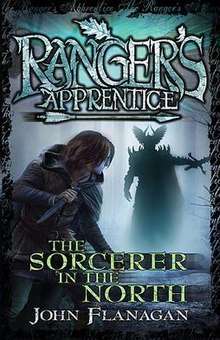The Sorcerer in the North
The Sorcerer in the North (The Sorcerer of the North in the United States) is the fifth book in the Ranger's Apprentice series by Australian author John Flanagan. It was released in Australia on 4 November 2006 and in the United States on 4 November 2008.
 Second Australian edition cover of The Sorcerer in the North | |
| Author | John Flanagan |
|---|---|
| Country | |
| Language | English |
| Series | Ranger's Apprentice (Book no. 5) |
| Genre | Fantasy, Adventure |
| Publisher | Random House (AUS) |
Publication date | 4 November 2006 (AUS) 4 Nov 2008 (USA) 6 August 2009 (UK) |
| Media type | Print (Paperback) |
| Pages | 329 |
| ISBN | 1-74166-128-5 |
| OCLC | 156766604 |
| A823.4 | |
| Preceded by | Oakleaf Bearers |
| Followed by | The Siege of Macindaw |
Plot summary
The book starts off with Will (a Ranger) rescuing a dog that he finds wounded on the side of the road, injured by a spear. Will then goes on to Castle Seacliff, the castle he has been assigned to and has a meeting with the Baron of the Castle Seacliff. After the meeting, a group of Skandians attempt to raid the castle and Will makes a deal with them: If he gives them food and water, the Skandians will leave. Before the Skandians leave, Will captures the man who hurt his dog and hands him over to the Skandians to become a slave.
Will is assigned to a mission to find out who the mysterious magician in Grimsdell Wood is and to stop him from terrorizing the castle of Macindaw. Will goes under disguise as a jongleur; somebody who acts as a jester but doesn't serve a king, going around the kingdom entertaining for money. He does this because people tend to trust jongleurs, whereas people often clammed up around Rangers, due to the mystery surrounding their position. This would, in turn, help him to get information on Grimsdell Wood. Will travels to Macindaw, where their Baron, Lord Syron, has been poisoned and is now in the hospital. His son Orman has taken over the castle while his father is ill, but Orman's cousin Keren has been trying to take over as Baron, but Will does not know this yet. Will rides to Grimsdell and sees the Night Warrior, one of the ghosts in Grimsdell, and flees in fear on his horse Tug.
Will performs for Orman during his dinner (in the great hall), but Orman claims he is a very bad jongleur due to his inability to play classical music. Will then meets Keren (who enters the dining hall late) and is under the impression that he is a very nice person. Alyss (Will's friend and a Diplomatic Service Courier) then comes disguised as a noblewomen. The next day Will sees sorcery books on Orman's table and suspects he's the magician in the woods. Will takes Alyss to Grimsdell wood during the day and Alyss works out how the magician made the Night Warrior. Following this Alyss sends a report to Halt and Crowley with a pigeon.
Halt (Will's former mentor) gets the report and decides he should send Horace, a knight on the king's guard as well as a friend of Will and Alyss, to help with Will's mission. Meanwhile, Orman had been poisoned too and is dying. The only way to help him is to go to the magician in Grimsdell Wood who used to be a healer (Will only suspects this but takes the chance). Will is forced to run for Grimsdell Wood but leaves Alyss behind in Castle Macindaw. Shadow (the name Will gave to his dog) finds a trail and leads them to Malcolm (the magician)'s house. He greets them after they see a giant walking around and other deformed people who Malcolm took in as helpers and patients. Will then tries to save Alyss, who has been captured by Keren, but Keren walks in the door and Will barely manages to escape alive.
References
External links
- The Sorcerer in the North at Random House Australia
- The Sorcerer of the North at Penguin Group (USA)
- The Sorcerer in the North at Random House UK
- The Sorcerer in the North at Random House NZ